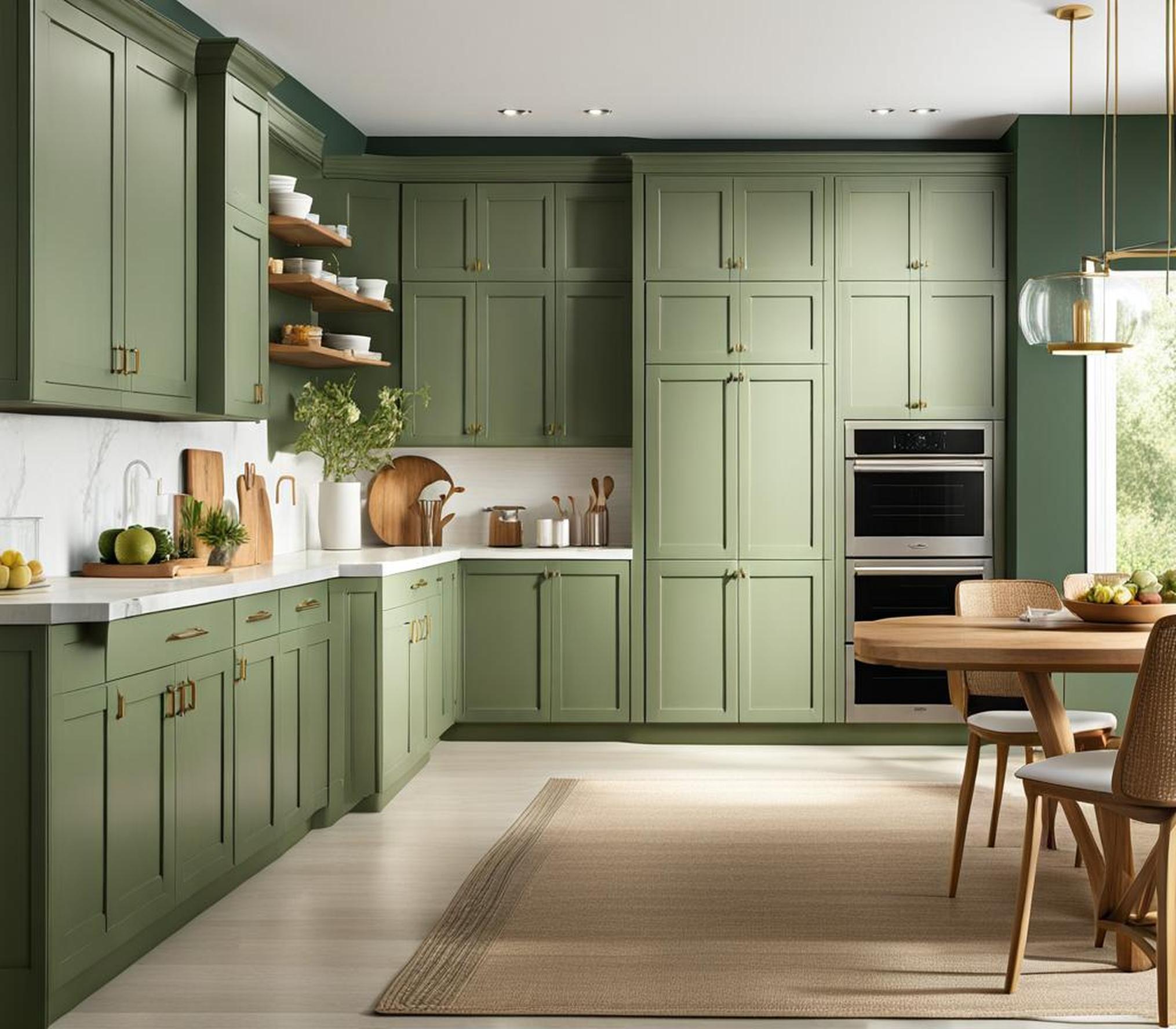Sage green kitchen cabinets can infuse warmth, calm, and nature’s essence into the heart of your home. When thoughtfully paired and properly illuminated, the right shade of sage green creates an inviting scene that uplifts both casual family meals and dinner parties alike.
But finding that “just right” sage green tone can also be an undertaking. Overly muted shades risk dullness, while saturated varieties might overwhelm. With so many sage green options for cabinets on the market, it’s key first to understand how sage color transforms under different conditions in the uniquely demanding kitchen environment.
Why Go Sage Green for Kitchen Cabinets?
The Timeless, Natural Appeal of Sage Green
The color green is mentally and emotionally associated with renewal, tranquility, rejuvenation and the natural environment. Within the vast range of greens, sages retaining the cool yellow undertones derived from nature provide a versatile, lighter green palette that energizes kitchen spaces with subtle vibrancy.
Unlike bolder grass greens, muted sage tones take on an adaptable neutral quality under the right conditions–complementing other features rather than competing with them. These harmonious qualities explain the surging popularity of sage green in kitchen cabinetry and interior design.
Setting the Scene: Sage Green Cabinet Pairings
While sage green cabinet paint unifies a kitchen’s look, the colors and textures surrounding the cabinetry impact sage perception significantly. Crisp white or off-white backsplashes and light counters create contrast that prevent sages from appearing dull or overly dominant.
Warm wood finishes like oak and walnut also synergize beautifully with sage green’s natural undertones. Meanwhile, durable surface materials like quartz or butcher block countertops withstand busy kitchen wear-and-tear while providing organic texture.
Lighting Considerations With Sage Green Cabinets
Sage green cabinet shades shift not only based on adjacent colors but also lighting conditions. Abundant natural light brings out the dynamic dimension in greens through highlighting undertones and adding liveliness.

Well-placed task lighting, pendant lights and undercabinet lighting similarly showcase sage green’s eloquent versatility for both food preparation and atmosphere. Insufficient illumination conversely leaves even vibrant sage greens appearing one-dimensional and dark.
Finding Your Perfect Sage Green Cabinet Shade
Lighter & Brighter: Airy Sage Greens
For small or dim kitchens, lighter sage green cabinet shades prevent closed-in feelings while maximizing brightness. The popular Benjamin Moore Saybrook Sage strikes an easygoing balance with warm, celery-like green pairing nicely with brass hardware and light granite.
Sherwin-Williams’ Clary Sage also hits the clean, lighter mark while carrying more yellow-citrus character. Its versatility spans various styles, though clary’s distinctive personality stands out more amid white backsplashes and dark metals.
With both lighter sages, saturations getting too muted or “pea soup”-like are easier pitfalls. Ensuring consistent lighting is key so these airy shades don’t appear washed-out or nondescript in certain spots.
Rustic & Rich: Woodsy Sage Options
Where pure brightness isn’t the priority, deeper woodland-inspired sage greens provide striking contrast beside lighter counters in spacious, sun-drenched kitchens. The evocative green Benjamin Moore aptly named Vintage Vogue conjures up antiqued countryside appeal.
While captivating, significantly darker sages like Vintage Vogue or Sherwin-Williams’ Shade Grown demand sufficient lighting and brighter pairings to energize their uniquely bold facades without seeming overpowering or dreary.
The Middle Ground: Flexible Sage Varieties
Splitting the difference, flexible sages like Sherwin-Williams’ bestselling Svelte Sage offer stylish adaptability between the light and deep ends of the sage spectrum.
Svelte Sage’s versatility arises from a balanced muted quality accessible enough for smaller kitchens yet carrying a sage essence substantial enough for larger spaces too. Its middle-of-the-road toning allows pairing with multiple styles from modern to transitional to rustic.
Final Takeaways: Choosing Your Best Sage Green
Trying Before You Buy: Paint Swatches & Samples
When pondering between sage tones, there is no substitute for witnessing their unique contrasts and diffusion effects beside your existing kitchen elements. Many retailers offer free paint strips or small samples to preview colors.
Full swaths painted on easily covered vertical cardboard test more accurately how lighting influences sage perception throughout daytime and evening hours. Sections of peel-and-stick removable wallpaper also provide non-permanent sage audition opportunities.
Trusting Your Instincts: Personal Preference Rules
Technical considerations around color theory and decoration trends provide helpful guidelines when selecting the most synergistic sage for one’s space.
Yet our emotional responses and deeper connections to colors remain highly individualized. If balancing lighting warmth and adjacent pairings still leaves you torn between two sage options, choose the one that keeps drawing you back.
While shades can read differently over time as other kitchen elements evolve, your core color preferences tend to remain reliable guides, ensuring the hue bringing you joy upfront maintains engaging appeal.
Infusing personality into the hardworking kitchen without overpowering remains an artful balance. For those seeking to imbue their food preparation hub with verdant tranquility effortlessly blending modern and timeless rurality, few cabinet makeover colors satisfy like the right sage green.
Attuning lighting, counter textures and accessorizing metals harmonizes sage for a scene as functionally inviting as it is aesthetically heartening. Renewed appreciation of the meaningful moments made together around meals fills out thelasting dividends of sage green’s graceful versatility.
